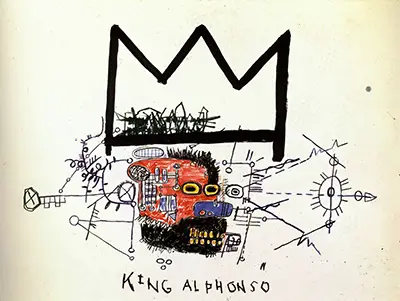Originally designed using acrylic and charcoal on paper for his series “The Daros Suite”, this explosive artwork employs many of the elements typically found in the work of Basquiat: a three-pointed crown, schematic, abstract representations accompanied by an enigmatic text and the predominance of the king's head — representing the triumph of thought and intellect over physical prowess — over the other elements in the frame.
Jean-Michel Basquiat was born in New York City in 1960, the son of immigrant parents from Haiti and Puerto Rico. A precocious student, from a young age he observed the struggles between rich and poor, Caucasians and Afro-Americans, the famous and the down-trodden. This, along with a period of time convalescing as a child, during which he became familiar with Gray’s Anatomy, were his main influences during his early career.
King Alphonso, as in a number of other works by this influential artist, features Basquiat’s famous three-pronged crown towering over a stylized reggae-type, Afro-American visage. Basquiat’s extensive use of crowns has been suggested by art critics as revealing of his awareness, even as a youngster, of his future destiny for greatness. The “W” shape evident in his crowns has been speculated by connoisseurs as well as casual art-lovers to be a reference to his close friend and artistic partner, Andy Warhol.
Basquiat’s style is deceptive in its simplicity, appealing and enticing in its bluntness. At first glance, King Alphonso may appear to be merely the idle doodlings of a child. But upon closer inspection, Basquiat’s keen intellect, his piercing commentary on human nature, his brilliant observations of the mechanisms of his own mind and thought processes become apparent.
In spite of the sophistication and maturity of these observations, the style also displays the playfulness and spontaneity of a child. Basquiat’s drawing is filled with the leaves, curlicues and random-appearing lines that often characterize the sketches carried out in a state of daydream in the margins of a schoolboy’s notebooks.
Basquiat’s mind is chaotic, impulsive, whirling with creative genius and ingenious inventions which he must then struggle to express in a coherent fashion in the mediocre physical media available in our world: acrylic, graphite, charcoal and oils. King Alphonso is a brilliant example of Basquiat’s masterful resolution of this internal battle.


